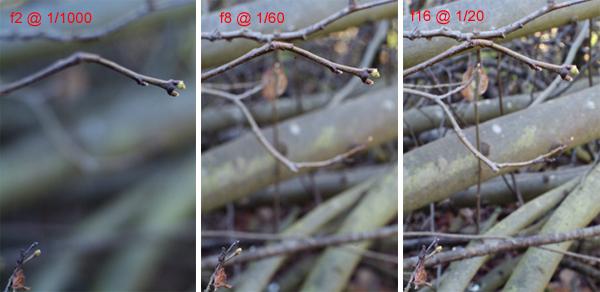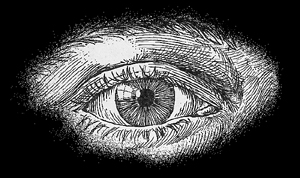How
does aperture affect depth of field?
The aperture
setting, or opening of the lens has an affect on the depth of
field. Regardless of the format of the camera or the focal length of the lens ,
as the aperture is changed, the depth of
field alters.
|
 |
A large aperture opening of f 2 (as in the top diagram) produces
less depth of field in an image while smaller opening
(as in the lower diagram) f 16 produces more depth of field
in the image. |

Here the point
of focus has not been moved - but as aperture is stopped down more
aspects of the tree come into focus. Look how limited depth of field
can be use to separate the foreground from the background as in the
image on the left.
Note
that there is less depth of field closer to the camera position from
the point of focus than in the distance. As a general rule, remember
to allow for this by focusing on a point closer than mid way, about
1/3 from the closest object you want in focus. The remaining
2/3 of the area in apparent sharp focus will relate to the objects further
away from the point of focus.
f/stop
- The smallest diaphragm openings produce the greatest relative DOF
however the image sharpness is actually less than a moderate opening
produces because of diffraction or bending of the light rays. Light
rays which closely pass an edge bend toward the edge as they go by much
like when you touch the side of the stream of water falling from a tap
(try it). The stream (or a portion of it) will bend toward your finger.
The rays thus scattered are then out of focus. Diffraction occurs at
any lens opening but since the proportion of diffracted rays to non-diffracted
rays is greater with very small openings than with larger openings,
the image sharpness is slightly less at the smaller openings. The faucet
experiment works to show this effect too. Open the tap to the smallest
steady stream you can and lightly touch the side of the stream with
your finger. Chances are the entire stream will be diverted toward your
finger. Now open the tap further. As the volume of the stream increases,
less of it touches your finger and more of it falls straight.
Lens quality - Aside from actual differences in the quality of lenses,
no lens is equally sharp at all the available diaphragm openings. The
maximum sharpness of a lens is obtained in the middle range of the available
f/stops. For example, if you have a 50mm lens with a range of f/2 to
f/16, your lens is probably sharpest when used at f/5.6 or f/8. This
is because of the limits of lens design. Maybe someday we'll figure
out how to design a lens that is equally sharp at all openings but we
are not there yet. In the meantime lens designers go for the greatest
sharpness in the middle range and compromise on the rest. Although not
a lens you should consider your filters as part of the lens. Buy the
very highest quality you can afford. They are in the light path and
your image will be only as good as can be produced by the lowest quality
piece of glass (resin, plastic or gelatin) in the light path. It should
be obvious that you must keep all your lenses and filters clean.

Move over image for roll over image
Sometimes it is useful to think of the relationship of the aperture
and depth of field like the way the pupil of our our operates. In
bright conditions when there a great deal of light closes up to a
small opening, but we see the image very sharply. While
in dim conditions it opens to let more light in but the image becomes
less distinct.
Two other
factors play a part in depth of field:
subject distance
focal length
Want to learn more? - do a workshop or one on one with Lloyd Godman